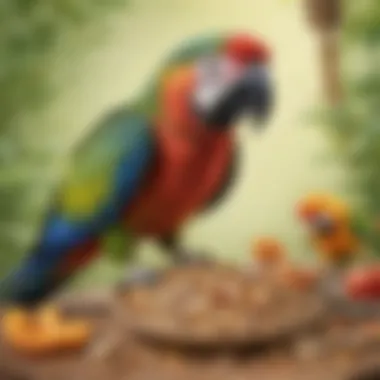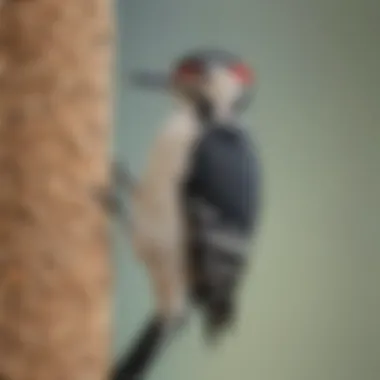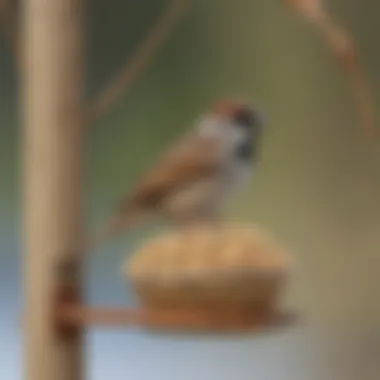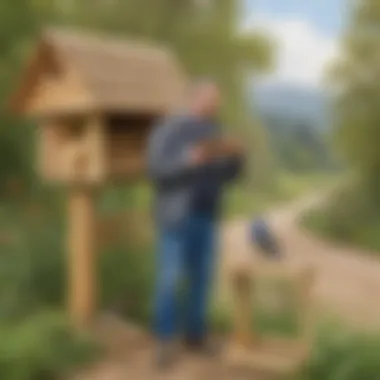Crafting Your Own Bird Seed Mix: The Ultimate DIY Guide for Bird Enthusiasts


Science Fun Facts
Birds are astonishing creatures that display remarkable abilities in their daily lives, from singing melodious tunes to executing intricate flight patterns with precision. Did you know that some bird species can mimic sounds they hear in their environment, including human speech? Imagine a feathered friend echoing your words back to you!
When it comes to birdfeeding, each bird species has specific dietary requirements to maintain their optimal health. For example, finches prefer smaller seeds such as nyjer and millet, while cardinals and jays enjoy heartier options like sunflower seeds and peanuts. By understanding these preferences, you can attract a diverse array of avian visitors to your backyard oasis.
A vital aspect of DIY bird feeding is ensuring that the seeds provided are fresh and uncontaminated. Seeds that are stored improperly can spoil and lose their nutritional value, potentially harming the birds that consume them. Storing your bird seed mixes in a cool, dry place in airtight containers can help maintain their freshness and keep pesky pests at bay.
Discover the Wonders of Science
Embark on a scientific journey as you explore the nutritional needs of different bird species and how to create custom blends that cater to their unique preferences. Delve into the world of ornithology and discover the fascinating intricacies of avian biology.
Through educational videos and animations, enhance your understanding of bird behavior and ecology. Witness the beauty of nature as you observe birds soaring through the sky or foraging for food on the forest floor. By immersing yourself in these visual elements, you can deepen your appreciation for the feathered friends that visit your outdoor space.
Real-life applications of science come to life as you experiment with various seed combinations and observe the reactions of different bird species. By applying scientific principles to your bird feeding practices, you can fine-tune your mixtures to attract specific bird species while promoting their overall well-being.
Science Quiz Time
Engage in interactive quizzes that challenge your knowledge of bird species, seed types, and feeding behaviors. Test your understanding of avian anatomy and physiology through brain teasers and puzzles that stimulate critical thinking and problem-solving skills.
Multiple-choice questions provide a fun and educational way to reinforce your learning and retention of valuable information. Take advantage of gamification strategies to make the learning process enjoyable and dynamic for both children and adults.
Science Experiment Showcase
Unleash your creativity with fun and engaging experiments that explore the impact of different seed mixtures on bird activity and health. Follow step-by-step instructions to craft specialized blends, noting the materials required and safety precautions to consider.
By creating a bird seed experiment showcase, you can observe firsthand the interactions between birds and varying seed compositions. Document your findings and reflect on the outcomes to further refine your DIY bird feeding practices for optimal results.
Introduction
Bird feeding has long been a cherished pastime for nature enthusiasts and conservationists alike. In this comprehensive guide, we delve into the art of creating your bird seed, providing valuable insights into the benefits and intricacies of DIY bird feeding. For individuals passionate about bird watching, conservation efforts, and fostering sustainable ecosystems, this article serves as a gateway to not only observe but actively contribute to the well-being of local avian populations.
Understanding the Importance of Bird Feeding
What drives the interest ina DIY bird feeding?
Given the growing interest in sustainable practices and wildlife conservation, DIY bird feeding has emerged as a popular trend among nature lovers. The allure of creating personalized bird seed mixes lies in the ability to control the quality of ingredients, ensuring a nutritious and tailored diet for our feathered friends. By opting for DIY solutions, individuals can play a more active role in nurturing local bird species, fostering a deeper connection with nature through hands-on engagement.
Benefits of feeding birds in youra area
Feeding birds in youra area yields multifaceted benefits, ranging from promoting biodiversity to bolstering the overall health of avian populations. Through regular feeding, enthusiasts can attract a diverse array of bird species, creating a vibrant ecosystem right in their backyards. Furthermore, providing a reliable food source during critical periods like winter fosters survival skills among birds, contributing to stronger, more resilient wildlife communities. The tangible satisfaction of witnessing birds thrive on meticulously crafted seed blends adds a profound sense of fulfillment to the act of bird feeding.
Benefits of Making Your Own Bird Seed


Making your bird seed offers a myriad of advantages, a practice highlighted in this detailed guide that emphasizes sustainable bird feeding practices and environmental consciousness. By creating your bird seed, you have complete control over the ingredients, ensuring a nutritionally balanced diet for our feathered friends. This process also allows for customization tailored to local bird species, catering specifically to their preferences. Additionally, the cost-effectiveness of DIY bird seed cannot be overstated, as it allows for savings through bulk purchasing and reduction of overall feeding expenses. Crafting your bird seed not only benefits the birds in your area but also contributes to the larger ecosystem by promoting healthy avian populations. Meticulously selecting each component of the bird seed ensures that fillers and additives are eliminated, providing a pure and wholesome dietary option for the birds.
Control Over Ingredients
Selecting quality components for bird seed
The process of selecting high-quality components for bird seed is a crucial aspect of DIY bird feeding. By choosing top-tier ingredients, you guarantee a healthy and nutriuous dietary option for local avian species. The selection process involves meticulous research to identify the best seeds, nuts, grains, and fruits available. Opting for premium ingredients ensures that your feathered visitors receive the best in terms of taste and nutrition, promoting their overall well-being and vitality. Quality components for bird seed are essential for attracting a diverse range of bird species, enriching your birdwatching experience and supporting avian biodiversity in your area.
Eliminating fileres and additives
Eliminating fillers and additives from your bird seed mix is crucial for providing birds with a pure and unadulterated food source. By excluding unnecessary additives, you ensure that the dietary preferences and nutritional needs of local bird species are met. This meticulous attention to detail sets DIY bird feeding apart, offering a natural and wholesome feeding option that promotes bird health and sustenance. The absence of fillers and additives in your bird seed mix enhances its nutritional value, attracting a wider variety of bird species to your feeding stations.
Cost-Effectiveness
Saving money by bulk purchasing
By harnessing the power of bulk purchasing, DIY bird seed making becomes a cost-effective solution for bird enthusiasts. Buying ingredients in larger quantities allows for significant savings in the long run, reducing the overall cost of bird feeding. This economical approach not only benefits your pocket but also enables you to provide a steady supply of quality food for your feathered visitors without breaking the bank. By leveraging bulk purchasing, you ensure a continuous and sustainable food source for local bird populations, fostering a harmonious coexistence between humans and wildlife.
Reducing overall feeding costs
Reducing the overall feeding costs of maintaining bird feeders is a key advantage of making your bird seed. By carefully crafting nutritionally balanced seed mixes at home, you minimize the need for frequent refills and commercial bird seed purchases. This reduction in feeding costs not only saves you money in the long term but also enables you to monitor and control the quality of the food provided to birds. Customizing seed mixes tailored to the dietary requirements of local bird species ensures that each feeding session is cost-effective and beneficial for both the birds and the environment.
Tailoring to Local Bird Species
Researching local bird preferences
Tailoring your bird seed mix to match the preferences of local bird species requires thorough research and understanding of avian dietary habits. By investigating the food choices of birds indigenous to your area, you can create specialized seed mixes that cater to their specific needs and tastes. This tailored approach not only attracts a diverse range of avian visitors but also promotes a deeper connection with the local bird population. Researching local bird preferences empowers you to provide a welcoming and nourishing environment for native birds, enriching your birdwatching experience and fostering a sense of stewardship towards the avian community.
Customizing seed mixes for diverse avian visitors
Customizing your bird seed mixes to accommodate a variety of bird species enhances the diversity of avian visitors to your feeding stations. By blending a selection of seeds, nuts, fruits, and grains, you create a versatile and enticing menu for different bird species. This customized approach promotes inclusivity and ensures that all birds, regardless of their dietary preferences, can find suitable sustenance in your feeders. By offering diverse seed mixes, you not only attract a wider range of birds but also contribute to the conservation of local avian populations, creating a dynamic and vibrant ecosystem in your backyard.
Selecting the Right Ingredients
Selecting the right ingredients is a crucial aspect of creating your own bird seed mixes. The quality of the components you choose will directly impact the nutritional value of the bird seed and the types of birds it attracts. By handpicking each ingredient, you have control over the final product, ensuring that it meets the specific dietary needs of the bird species in your area. Considerations such as the size of the seeds, their nutritional content, and their appeal to local bird species should guide your selection process.
Seeds and Grains
Sunflower seeds
Sunflower seeds are a popular choice in bird feeding due to their high levels of healthy fats and proteins. These nutrient-dense seeds attract a wide variety of bird species, making them a versatile option for your homemade bird seed mixes. Their large size also appeals to larger birds, while smaller birds can efficiently crack open the shells to access the tasty kernels.
Safflower seeds
Safflower seeds are known for their bitter taste, which deters squirrels and some invasive bird species while still being highly desirable to native songbirds like Cardinals and Grosbeaks. Their high oil content makes them a valuable source of energy for birds, especially during colder seasons when food is scarce. Including safflower seeds in your mix can help diversify the avian visitors to your feeder.


Millet
Millet is a tiny but nutrient-rich seed that appeals to a wide range of bird species. Its small size makes it suitable for birds with delicate beaks, such as finches and sparrows. Millet is an excellent source of carbohydrates and provides essential energy for birds, especially during nesting and migration periods. Including millet in your bird seed mix can attract a diverse array of small songbirds to your feeders.
Nuts and Legumes
Peanuts
Peanuts are a favorite among many bird species due to their high protein content and energy-rich fats. Birds like woodpeckers, nuthatches, and blue jays are particularly fond of peanuts, making them a great addition to your DIY bird seed mixes. However, be cautious about using salted or flavored peanuts, as they can be harmful to birds. Opt for unsalted, raw, or roasted peanuts for the healthiest option.
Almonds
Almonds are a nutritious nut choice for bird feeding, providing essential fats and proteins. While not as commonly used as peanuts, almonds can still attract birds like chickadees and titmice to your feeder station. Ensure you crush or chop the almonds into smaller pieces to make them more accessible to a wider range of bird species. Utilize almonds in moderation to prevent crowding at the feeders and reduce wastage.
Dried peas
Dried peas are a cost-effective and protein-rich option for enriching your bird seed mixes. Birds such as doves, pigeons, and certain sparrows enjoy feeding on dried peas, which offer a good source of sustainable energy. Including a variety of legumes like dried peas can help diversify the nutritional profile of your bird seed recipes, catering to different avian dietary preferences.
Fruits and Berries
Raisins
Raisins are a sweet and energy-packed treat for fruit-eating birds like orioles, robins, and waxwings. Their natural sugars provide an instant energy boost, making them a sought-after addition to bird seed mixes. Ensure the raisins are preservative-free and free of sulfur dioxide, as additives can be harmful to birds. Mixing raisins with other dried fruits can create a colorful and enticing blend for fruit-loving bird species.
Cranberries
Cranberries are rich in antioxidants and offer a tangy flavor that appeals to fruit-loving birds. Species such as thrushes, waxwings, and mockingbirds are known to enjoy cranberries as part of their diet. Including cranberries in your bird seed mix adds both nutritional value and sensory variety, enhancing the feeding experience for your backyard visitors.
Banana chips
Banana chips are a delightful tropical addition to bird seed mixes, attracting species that enjoy a hint of sweetness in their diet. Birds like warblers, tanagers, and orioles are known to relish banana chips as a source of quick energy. Opt for naturally dried banana chips without any additional sugar or preservatives to offer a healthy snack option for your feathered friends.
Mixing and Storing Your Bird Seed
In the context of this guide on creating your bird seed, the section on Mixing and Storing Your Bird Seed plays a vital role in ensuring that your feathered friends receive the best nutrition possible. When it comes to Mixing and Storing Your Bird Seed, there are specific elements to consider to maintain freshness and quality. Properly blending different seeds, grains, nuts, and fruits ensures a balanced diet for birds, promoting their health and well-being. Proper storage techniques are equally crucial to prevent spoilage and maintain the nutritional integrity of the bird seed mix. By understanding the importance of Mixing and Storing Your Bird Seed, bird enthusiasts can actively contribute to the well-being and sustainability of local avian populations.
Creating Balanced Seed Ratios
Honing in on the subsection of Creating Balanced Seed Ratios, a key aspect to delve into is the understanding of nutritional needs of birds. By comprehending the specific dietary requirements of different bird species, individuals can tailor their seed mixes to cater to these needs adequately. Understanding the nutritional needs of birds involves grasping the appropriate balance of proteins, fats, and carbohydrates in bird diet, ensuring they receive the essential nutrients for their growth and energy requirements. This meticulous attention to detail in Creating Balanced Seed Ratios ensures that birds receive a comprehensive and nutritionally adequate diet, supporting their overall health and vitality.
Understanding nutritional needs of birds
One crucial element in catering to birds' nutritional needs is the adequate provision of proteins, fats, and carbohydrates in their diet. Balancing these components ensures that birds have access to the necessary energy sources and building blocks for physiological functions. Understanding nutritional needs of birds allows bird enthusiasts to create seed mixes that address specific dietary requirements, thus promoting optimal health and well-being among avian populations. By focusing on the nutritional content of bird seed mixes, individuals can contribute significantly to the conservation of bird species and overall ecosystem health.
Balancing proteins, fats, and carbohydrates


Another pivotal aspect of Creating Balanced Seed Ratios is the meticulous balance of proteins, fats, and carbohydrates in bird seed mixes. This balance is essential to support birds' diverse nutritional needs, enabling them to thrive and flourish in their natural habitats. Balancing proteins, fats, and carbohydrates in bird seed mixes requires a nuanced understanding of bird physiology and dietary preferences. Achieving this balance empowers bird enthusiasts to provide tailored nutrition for local avian populations, fostering biodiversity and ecological harmony within bird communities.
Proper Storage Techniques
Transitioning to the subsection of Proper Storage Techniques, the focus shifts to maintaining the freshness and quality of bird seed mixes. Airtight containers emerge as a crucial component in preserving the nutritional value of bird seed, preventing exposure to moisture and pests that can compromise seed quality. The use of airtight containers ensures that bird seed remains fresh and appetizing for avian visitors, promoting regular consumption and sustained interest in feeding stations.
Airtight containers
Key to the longevity of bird seed mixes is the utilization of airtight containers for storage. Airtight containers offer a protective seal that shields bird seed from environmental factors, preserving its freshness and nutritional content over time. By storing bird seed in airtight containers, individuals can extend the shelf life of their seed mixes, reducing waste and ensuring that birds receive high-quality nutrition consistently. The incorporation of airtight containers into bird feeding practices underscores a commitment to excellence in avian care and conservation.
Cool, dry storage areas
Complementing the use of airtight containers, selecting cool, dry storage areas contributes to maintaining the efficacy of bird seed mixes. Cool, dry environments mitigate the risk of mold and spoilage, safeguarding the nutritional integrity of bird seed against adverse conditions. By storing bird seed in cool, dry locations, bird enthusiasts safeguard the well-being of local avian populations, offering them fresh and wholesome nutrition that supports their daily dietary needs. The conscientious choice of storage areas further emphasizes the dedication to providing optimal nourishment for birds and fostering a sustainable relationship with avian wildlife.
Feeding Strategies and Best Practices
Feeding Strategies and Best Practices play a crucial role in the realm of DIY bird feeding. It is imperative to understand the significance of proper feeding strategies to ensure the well-being of the avian visitors in your area. By implementing efficient feeding practices, you contribute to the sustainability of local bird populations and foster a harmonious coexistence between humans and wildlife. In this section, we will delve into the key elements of Feeding Strategies and Best Practices, exploring how they impact the overall success of DIY bird feeding.
Feeder Placement
Choosing suitable feeder locations
Choosing suitable feeder locations is a critical aspect of bird feeding that can significantly influence the effectiveness of your feeding station. The strategic placement of feeders can attract a diverse array of bird species while minimizing potential hazards. Opting for locations that are easily accessible to birds but out of reach for predators is paramount. Moreover, considering factors such as visibility, proximity to shelter, and ease of monitoring are essential in determining the ideal placement for your feeders.
Protecting feeders from predators
Protecting feeders from predators is a vital consideration when setting up your bird feeding station. By installing predator deterrents such as baffles, poles, or cages, you can safeguard the feeding area from unwanted intrusion. Understanding the behavior of common feeder pests and implementing appropriate preventive measures is key to ensuring a safe and stress-free dining environment for your feathered guests. Balancing accessibility for birds with security measures against predators is a delicate yet crucial aspect of successful bird feeding practices.
Monitoring and Refilling Feeders
Regularly checking seed levels
Regularly checking seed levels is a fundamental task in maintaining a healthy and sustainable feeding station. Keeping track of seed consumption allows you to gauge bird activity, adjust feeding regimes, and replenish supplies in a timely manner. By monitoring seed levels, you can ensure a continuous food source for birds throughout the day, enhancing their well-being and fostering regular visits to your feeder. This practice promotes a consistent and reliable food supply, contributing to the overall satisfaction of your avian visitors.
Cleaning and refilling feeders
Cleaning and refilling feeders is a meticulous process that is essential for upholding bird hygiene and preventing the spread of diseases. Regular cleaning removes dirt, mold, and residue that can contaminate bird food and harm visiting birds. Refilling feeders with fresh seed ensures a constant food source and discourages avian guests from seeking alternative, potentially harmful food elsewhere. Maintaining clean and well-stocked feeders demonstrates your commitment to bird welfare and enhances the overall bird feeding experience.
Conclusion
Bird feeding plays a crucial role in maintaining ecological balance and supporting local wildlife populations. By creating your own bird seed, you contribute to fostering sustainable ecosystems and aiding in the preservation of avian species. The act of DIY bird feeding not only benefits the bird population but also provides a sense of fulfillment for the feeder. Understanding the nutritional requirements of different bird species enables feeders to tailor their seed mixes accordingly, promoting healthier avian communities. Moreover, engaging in bird feeding activities encourages a closer connection with nature and fosters a sense of responsibility towards wildlife conservation efforts.
Encouraging Sustainable Bird Conservation
Promoting healthy ecosystems through bird feeding
Promoting healthy ecosystems through bird feeding is a fundamental aspect of DIY bird feeding, emphasizing the interconnectedness between avian species and their habitat. By providing nutritious bird seed, feeders support the overall health and reproductive success of birds, contributing to a balanced ecosystem. This practice promotes biodiversity and helps in maintaining stable bird populations, ultimately creating a thriving environment for various avian species. The key characteristic of promoting healthy ecosystems through bird feeding lies in its ability to improve the overall well-being of local bird communities, enriching the ecological landscape.
Contributing to local wildlife preservation efforts
Contributing to local wildlife preservation efforts is a paramount contribution of DIY bird feeding towards conservation initiatives. By providing sustainable food sources for birds, feeders play a vital role in ensuring the survival and well-being of avian species in their vicinity. This practice aids in mitigating the impact of habitat loss and environmental changes on bird populations, thereby acting as a proactive measure in wildlife preservation. The unique feature of contributing to local wildlife preservation efforts is its direct impact on enhancing the resilience of local bird populations, reinforcing the importance of individual actions in broader conservation strategies.







